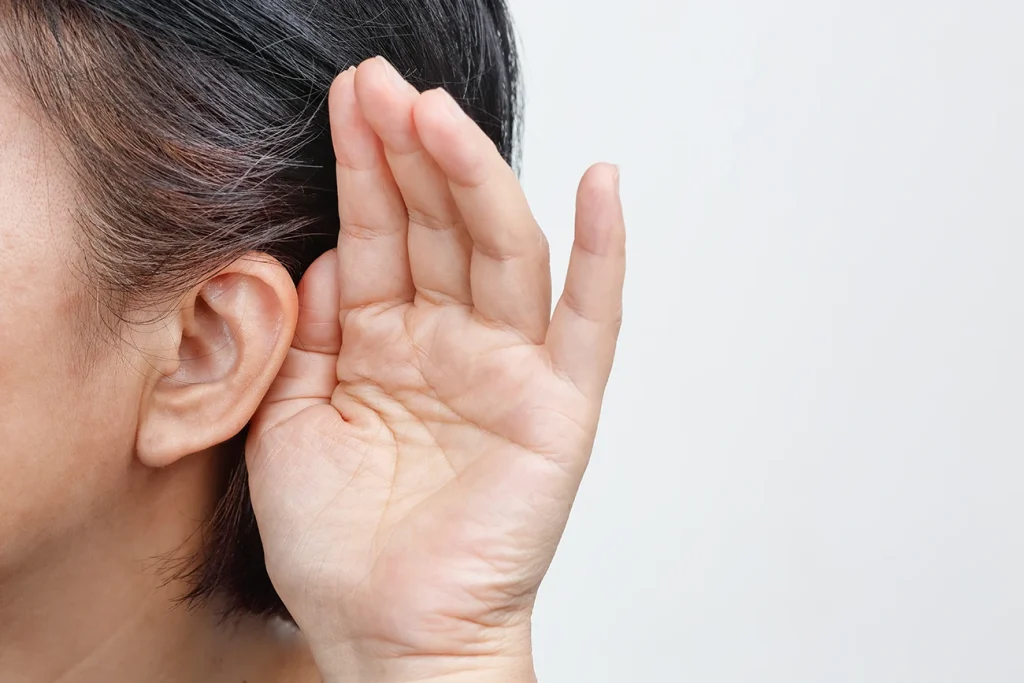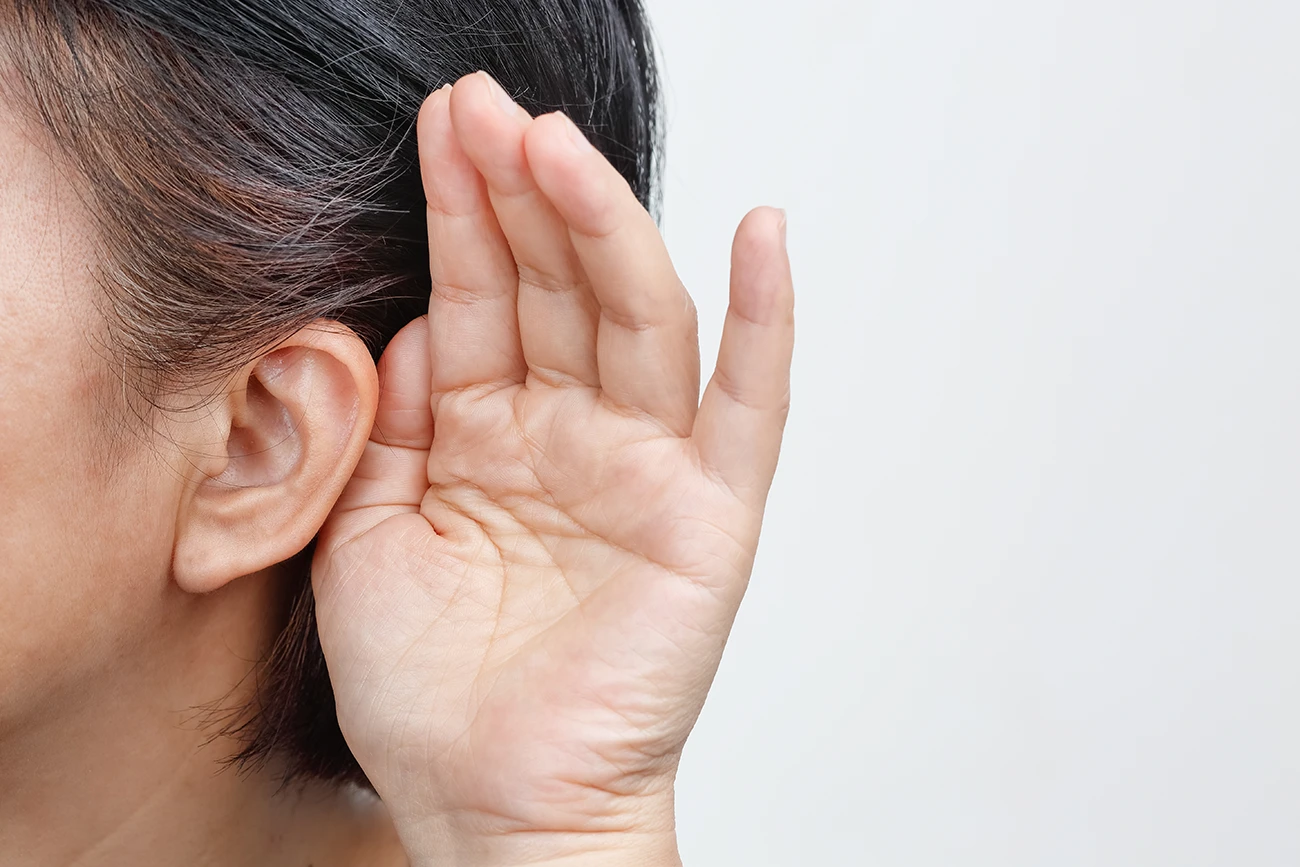Conductive hearing loss occurs when something blocks the sound waves from the outer or middle ear from reaching the inner ear. It reduces the loudness of sounds, but does not affect their clarity.
Fortunately, most conductive hearing losses are treatable or reversible. Timely evaluation and management can prevent complications such as increased stress, irritability and reduced focus over time.
Symptoms
Symptoms of conductive hearing loss occur when sound can’t efficiently travel through your outer or middle ears to reach your inner ear. This type of hearing loss can be temporary or permanent and may affect one or both ears. You may notice that sounds are muffled or that it’s difficult to hear soft noises or voices. This type of hearing loss can be caused by obstructions, injuries or irregularities anywhere from the pinna and the external ear canal to the malleus, incus and stapes bones of your middle ear.
A child may experience conductive hearing loss from chronic ear infections or from objects that become trapped in their ear canal. In adults, conductive hearing loss can be caused by an injury to the ear or head, or by certain diseases such as otosclerosis.
Your healthcare provider will perform a physical exam and use a lighted instrument called an otoscope to look in your ear canal and eardrum for blockages or other structural abnormalities. Your healthcare provider may also test your hearing with a pure-tone audiogram and an acoustic reflex test to determine the severity of your condition. The acoustic reflex test measures the tightness of a muscle in your middle ear (stapedial muscle) and the ability to vibrate a tuning fork when placed adjacent to the ear canal or touched against the bone behind the ear drum (bone conduction).
Treatment for conductive hearing loss depends on the underlying cause. If excessive earwax buildup is the issue, your healthcare provider may recommend removing it with specialized tools or irrigation techniques. If a tumor, cyst or other abnormal growth is blocking the eardrum or other middle ear structures, surgery may be required to remove the growth or repair damage. For conductive hearing loss that is a result of permanent damage to your eardrum or ossicles, hearing aids can be used to amplify sounds so they’re easier to hear. Prevention strategies include regular ear checkups to identify problems and prevent them from getting worse, proper ear hygiene to avoid using cotton swabs in the ear canal where this can push earwax deeper into the ear canal, and avoiding loud noises that can cause hearing damage.

Diagnosis
The most accurate diagnosis of conductive hearing loss is done through a comprehensive hearing test. Hearing healthcare specialists review your medical history and perform a physical exam of the ear, looking for blockages or structural problems. They may also use a lighted instrument called an otoscope to look inside the ear canal and feel around the ear. They will also ask questions about your symptoms and perform various tests, including a pure-tone audiometry test and an otoacoustic emissions (OAE) test to measure the vibrations of your inner ear.
Conductive hearing loss occurs when sound waves aren’t able to reach your inner ear, due to damage or blockage in the outer or middle ear. This can happen from a variety of reasons, including ear infections, earwax buildup, perforations in the eardrum or problems with three small bones in the middle ear. Symptoms of conductive hearing loss include louder sounds being muffled and being unable to hear softer sounds, which is why it’s important to get prompt treatment.
Congenital conductive hearing loss is typically identified through newborn screening or in babies with facial abnormalities, and it can also occur later in childhood due to otitis media with effusion or chronic middle ear disease. In adults, conductive hearing loss can result from head trauma, infections or structural problems in the outer or middle ears.
Depending on the cause, conductive hearing loss can be temporary and often improved with medication or surgery. For example, ear infections can be treated with antibiotics or an ear irrigation procedure (myringotomy). Earwax blockage caused by excessive wax or swimmer’s ear can be irrigated with warm water or removed with a curette. Perforations in the eardrum can be sealed using surgery, and if they don’t heal themselves, they may need to be surgically repaired (myringoplasty).
Adults who experience conductive hearing loss should contact an otolaryngologist or audiologist for evaluation and care. They can perform tests, such as otoacoustic emissions and pure-tone audiometry, to determine how much hearing loss you have in one or both ears, at which frequencies, and which ear(s). They can also recommend treatment options, such as bone conduction hearing aids, that bypass the outer and middle ear by sending sound vibrations directly to your inner ear.
Treatment
Thankfully, most cases of conductive hearing loss are temporary and can be treated. Your ear, nose, and throat doctor, or an Ear Nose and Throat (ENT) specialist called an otolaryngologist, can provide a diagnosis and suggest treatment options. Often, treating the underlying cause of your child’s hearing loss will restore his or her ability to hear.
Conductive hearing loss is a result of something blocking the sound waves from traveling to the inner ear. This causes the sounds to be quieter and harder to hear. The most common cause of conductive hearing loss is the buildup of earwax, or cerumen. This natural substance is produced by glands in the ear canal to protect and lubricate the ears, but an overproduction of this wax can block your ear canal or irritate the eardrum. Other causes of conductive hearing loss include ear infections, or damage to the outer or middle ear structures.
A healthcare provider can diagnose a conductive hearing loss by looking at the outer ears and eardrum and feeling around the area for any blocks. A lighted instrument called an otoscope can also be used to see inside the ears for any obstructions or structural abnormalities. A pure-tone audiometry test may be performed to determine the quietest sounds your ear can hear at different pitches. Using a tuning fork, your healthcare provider will ask whether you can hear the vibration of the tuning fork more clearly adjacent to the ear canal (air conduction) or when touching the bone behind the ear (bone conduction).
Other tests may be done including an otoacoustic emissions test which measures the sound-related vibrations from the cochlea and can help identify a conductive hearing loss. If you or your child experience a conductive hearing loss, make an appointment with your local Audibel center today to learn more about the symptoms, causes, and treatments for conductive hearing loss. Early detection and treatment can improve your hearing health and overall quality of life! Click here to find a location near you.
Prevention
The good news is that most cases of conductive hearing loss are treatable. Often, the condition is temporary and can be corrected medically or surgically.
Conductive hearing loss occurs when a problem in the outer or middle ear keeps sound waves from reaching your inner ear. The inner ear is responsible for turning sound vibrations into electrical signals your brain can understand as sound.
When a blockage prevents sound from reaching your inner ear, the sounds you hear become muffled or indistinct. You may notice that the sounds of people talking, music and other environmental noises are difficult to hear.
If you have a conductive hearing loss, your doctor will recommend treatment for the underlying cause. For example, if your loss is due to earwax buildup, your doctor will remove the earwax through the ear canal or through surgery. Your doctor may also prescribe medication for ear infections or other conditions that cause conductive hearing loss, and if there is a hole in your eardrum, a surgeon will repair the hole.
In some cases, your healthcare provider may use a procedure called active surveillance to monitor your condition and take action only if the conductive hearing loss gets worse. For a more permanent solution, your doctor may recommend hearing aids that amplify sounds. They can be worn on a regular basis or can be used only when you are around loud noises.
To prevent hearing loss, it is important to practice proper hygiene by removing earwax regularly through your ears or with a commercial wax removal product. You should also wear earplugs or earmuffs in noisy environments to protect your hearing from damage caused by high-volume noise exposure. And you should seek emergency care if you experience sudden hearing loss, as this is more likely to be treated successfully if it is treated early. In addition, your healthcare provider can recommend a routine hearing test to screen for common problems that lead to conductive hearing loss, such as ear infections or abnormal growths. Prompt treatment of these issues can help minimize the impact on your health and quality of life.

